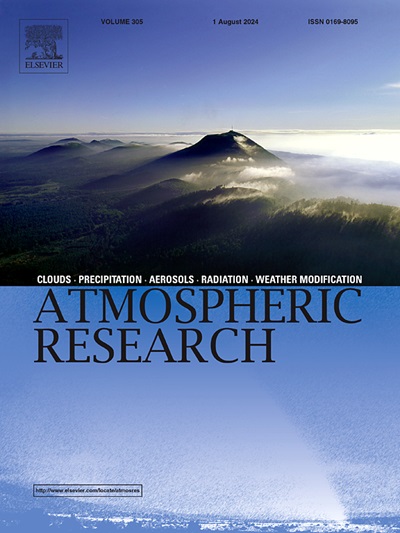利用偏振雷达观测对印度中部季风前对流云和冰雹风暴微物理的偏振分析
IF 4.4
2区 地球科学
Q1 METEOROLOGY & ATMOSPHERIC SCIENCES
引用次数: 0
摘要
本研究利用c波段双极化(CDPR)雷达在印度理工学院位于博帕尔以北60公里的Silkheda的大气研究试验台(ART)设施上观测到的季风前对流云(PMCC)和季风前月份产生冰雹的风暴。PMCC的综合分析表明,35 dbz和50 dbz回波顶的最大高度分别在13 km和11 km左右,表明对流强烈和深。季风前季节对流有效势能(CAPE)均值也较高。PMCC的复合等高线频率随高度图(CFADs)显示,PMCC在熔融层上方的差反射率值(ZDR ~ 0 dB)和比差相位(KDP)的频率较高,表明强烈的对流上升气流主导着PMCC,导致冰雹/霰颗粒在熔融层上方被大量包围并达到更高的高度。地表附近ZH、ZDR、KDP分布较宽或值较高,相关系数ρHV (<0.95)值较小,表明季风前期存在雨雹混合。探讨了2023年4月30日在博帕尔产生冰雹的雹暴事件的微物理特征。结果表明,该地区的CAPE值在此次冰雹事件发生前就开始积累,在博帕尔地区冰雹发生前CAPE值较高。风暴的时间演变表明5-11公里以霰/冰雹为主。霰/冰雹的形成是由于云滴、过冷水或冰粒的边缘或吸积过程。经观测,在风暴演化过程中,环化过程占主导地位,产生非常低的ZDR和KDP值。在这些高度ρHV值较高(>0.99),表明霰/冰雹是干燥的。上升气流与对流不稳定的大气有关,通过快速收集过冷的水滴,夸大了冰晶的生长。这最终导致了霰/冰雹的形成。在近地表观测到湿雹和大雨滴的特征,具有较高的ZH (>;50 dBZ),增强的ZDR (~ 3-4 dB)和耗尽的ρHV (<;0.95)。此外,近地表KDP值超过1.8°/km表明冰雹融化/被水包裹的过程。本文章由计算机程序翻译,如有差异,请以英文原文为准。
Polarimetric insights into pre-monsoon convective clouds and hail storm microphysics over central India using polarimetric radar observation
The present study characterizes the pre-monsoon convective clouds (PMCC) observed in the monsoon core zone and a hail-producing storm during the pre-monsoon month observed using C-band dual-polarization (CDPR) radar at the IITM's Atmospheric Research Testbed (ART) facility in Silkheda, 60 km north of Bhopal. The composite analysis of PMCC has shown that the maximum height of 35- and 50-dBZ echo tops (ETHs) is around 13 km and 11 km, respectively, indicating intense and deep convection. The mean value of Convective Available Potential Energy (CAPE) is also high for the pre-monsoon season. The composite contoured-frequency-by-altitude diagrams (CFADs) of PMCC show a high frequency of smaller values of differential reflectivity (ZDR ∼ 0 dB) and specific differential phase (KDP) above the melting layer, indicating that intense convective updrafts dominate the PMCC, causing hail/graupel particles to be rimmed heavily above the melting layer and reach greater heights. The wider distribution or higher values of ZH, ZDR, KDP, and small values of correlation coefficient ρHV (<0.95) near the surface indicate the presence of a rain-hail mixture during the pre-monsoon month.
The microphysical characteristic of a hailstorm event that produced hailstones over Bhopal on 30th April 2023 is explored. It is found that the CAPE value was building up before the hailstorm event, and it was high just before the hailstone was observed over Bhopal. Time evolution of storms indicates the dominant presence of graupel/hail at 5-11 km. Graupel/hail will form due to the riming or accretion processes of cloud droplets, supercooled water, or ice particles. It has been observed that the riming process is dominant during the storm's evolution, which produces very low values of ZDR and KDP. The high value of ρHV (>0.99) at these altitudes suggests that the graupel/hail is dry. The updraft associated with a convectively unstable atmosphere exaggerates the growth of ice crystals by a rapid collection of supercooled water droplets. That ultimately led to forming graupel/hailstones through the riming process. The wet hailstones and large raindrops signatures close to the surface are also observed and are characterized by higher values of ZH (> 50 dBZ), enhanced ZDR (∼ 3–4 dB), and a depleted ρHV (< 0.95). Additionally, a KDP exceeding 1.8°/km near the surface indicates the process of hail melting/hail coated with water.
求助全文
通过发布文献求助,成功后即可免费获取论文全文。
去求助
来源期刊

Atmospheric Research
地学-气象与大气科学
CiteScore
9.40
自引率
10.90%
发文量
460
审稿时长
47 days
期刊介绍:
The journal publishes scientific papers (research papers, review articles, letters and notes) dealing with the part of the atmosphere where meteorological events occur. Attention is given to all processes extending from the earth surface to the tropopause, but special emphasis continues to be devoted to the physics of clouds, mesoscale meteorology and air pollution, i.e. atmospheric aerosols; microphysical processes; cloud dynamics and thermodynamics; numerical simulation, climatology, climate change and weather modification.
 求助内容:
求助内容: 应助结果提醒方式:
应助结果提醒方式:


